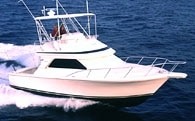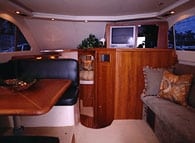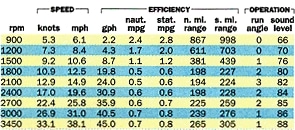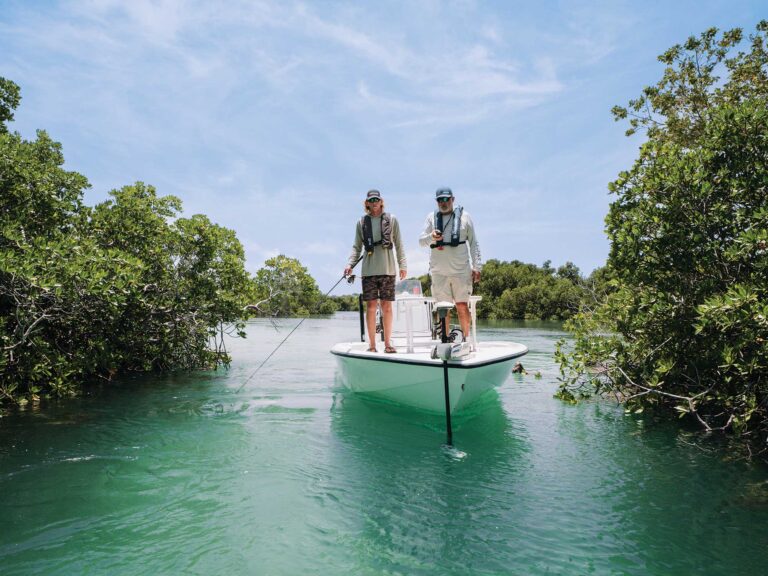
Phoenix 35

Phoenix 35

Phoenix 35 Specs

Phoenix 35
Men are from Mars, women are from Venus, and boats are from…Jupiter? Well, yes. At least the new Phoenix 35 is. How so? The Phoenix 35 is built by Jupiter Marine, which until now has been known only for its outboard-powered 27′ and 31′ center consoles. So the question is: Can such a boatbuilder resurrect a traditional sportfisherman and update it with a level of construction and style that’s competitive in the 21st century?
I tested the Phoenix 35 as a massive storm front moved in. As I cleared the inlet, waves were running one to two feet. Soon they reached three to four – and more. The sky grew dark and dangerous. The rain beat on us like a ball-peen hammer. It was a full-blown squall. Hey, what a great day to test a boat.
IMPROVED ATTITUDE. A boat that sits bow down at rest is going to have problems when underway. Bow steering, trouble getting onto plane, and nose stuffing are all possibilities. Despite its well-deserved reputation as a sturdy fishboat, the old Phoenix 34’s handling was another issue. It sat bow down. Jupiter addressed this problem by re-engineering the boat’s weight distribution. The goal: Move the boat’s center of gravity 8″ aft. The natural starting point was with the engines, which are responsible for 3,100 pounds of the Phoenix 35’s 23,890-pound overall weight; they were shifted 4″ aft.
THE HIGHS: Changes in prop pockets and weight distribution bring a classic into the 21st century. Wide open cockpit and thin transom are ideal for fighting big game on standup gear.** **
THE LOWS: Salon door latch is flimsy. Mist blows back into the cockpit at cruising speeds. No rigging station means you’ll have to pre-rig or bring along a cutting board and bucket.
I know what you’re thinking: Shuffle the engines farther under the deck and it’ll be hell to access them for maintenance. Well, that’s not a problem here, because the Phoenix 35’s engine boxes sit above deck level, forward in the cockpit. They swing open from the front, exposing every inch of the iron horses to your wrenches, rags, and ratchets. They also make two great aft-facing bait-watching seats when you’re on the troll. But won’t pushing the engines farther aft result in an increased shaft angle and reduce efficiency? Another valid concern, but it’s also been addressed with care. Added depth in the prop pockets allows for a better shaft angle and a shallower draft to boot.
More weight was moved aft by changing the battery, genset, and holding and fuel tanks. This shuffling does more than change the center of gravity. It allows more room for fuel, increasing the old Phoenix’s capacity of 300 gallons to 400. That matches the fuel capacity of the Luhrs 36 ($220,200 with the same amount of power). But the new Phoenix 35 cruises at about 30 mph compared to the Luhrs 36’s 28, so the Phoenix 35 will have a longer range at cruising speed.
With the performance issues taken care of, Jupiter then attacked the model’s vintage styling. A new flying bridge was designed, the salon windows were updated, and the entire boat was given a face-lift. Sharp looking? Modern? Yes. But that’s not the entire story. Applying Jupiter’s decades of experience creating high-end gel-coat fit and finish, special attention was paid to the Phoenix 35’s outer appearance. The Armourcote gel coat gives this boat a beautiful a mirror-like surface, and the care with which it is applied keeps that surface ripple-free. Underneath, there’s a barrier coat of vinylester resin. Dissect the hull further and you find multiple layers of biaxial glass and woven roving, laid up into a solid hull bottom. Hullsides above the waterline are cored with Klegecel closed-cell foam, as are the cockpit sole and the decks. This structure is supported by 1 1/2″-thick marine-ply stringers, made from a triple layer of 1/2″ ply glassed together and encapsulated in multiple layers of triaxial fiberglass. Seven transverse bulkheads are bonded into the hull with vinylester resin. The hull-to-deck joint is sealed with 3M’s 5200 adhesive, through-bolted, and fiberglassed together, completing the Phoenix 35’s Gibraltar-like structure.
One thing I didn’t like in terms of construction: The latch that holds open the cabin door is a thin, flimsy friction catch. Kick it once and it’ll be bent out of shape forever. The company said it would replace these latches on future models.
WATER CRUSH. Sure, all these design, styling, and construction changes sound neat. But when the pointy end of the boat smacks into a mound of salt water, what do they add up to? Comfort, security, and confidence all popped into my head as I opened up the throttles and punched through the waves. There was minimal movement whether in a head or trailing sea, and the thoroughly muted impacts were similar to those you’d feel on older, heavier, slower boats, such as 1970s vintage Bertrams. Don’t forget, though, that we were traveling much faster, nipping at the heels of 40 mph. Those old Bertrams ran at half that speed. We’re talking twice as fast, with similar comfort levels. One thing I didn’t like about the Phoenix 35’s performance at high speed: Tiny drops of airborne water have a tendency to roll back around the sides of the salon and flying bridge, keeping the cockpit moist. I’m not talking about spray here. It’s more of a mist, and on a hot July day you might actually like it. But northerners who make canyon runs in November definitely won’t.
There are a couple other features worth noting on the Phoenix 35. With its relatively low profile and low center of gravity, this boat is stable when waves hit on the beam. Your mate won’t have to do the side-to-side cockpit dance as you try to get the spread out, even if you decide to putt through the troughs. Backing this boat is also a pleasure. There are no vibrations, and chasing down a fish is as easy as it gets.
WEAPONS CHECK. And chase fish you will, after surveying this cockpit: Coaming bolsters, fresh- and raw-water washdowns, a 35-gallon circular livewell, insulated fishboxes, five rodholders, and two under-gunwale rodracks per side are all standard. More about that livewell: It’s located in the cockpit sole, which is advantageous because that means it doesn’t eat into cockpit room. However, it does mean you’ll have to bend over every time you need to scoop out another goggle-eye.
What’s not to like? There’s no integrated, standup rigging station, since its usual location forward in the cockpit is taken by the engine boxes.
What I like most about this cockpit is its wide open attitude. As stated, the engine boxes are the only thing above deck level, and they make nice bait-watching seats. While you rest your butt, look up and to either side. Over each engine box sits a three-drawer tacklebox. Of course, the lack of a real rigging station means you’ll have to pre-rig, or carry the old standby five-gallon bucket and a cutting board. Sure, that’s one more thing you need to carry around, but since it means more cockpit acreage, that’s a trade I’d make any day. And since the livewell and fishboxes are in the cockpit sole, the transom is only a few inches wide – the best situation for a fight on standup gear. Gaffing, tagging, and billing will also be easier, thanks to the thin transom.
LAST WORD. Any way you look at it, the Phoenix 35 has a new and improved attitude.
LOA…..36’10” ** **
Beam…..13’2″
Draft…..2’9″ ** **
Displacement (lbs., approx.)…..23,890 ** **
Transom deadrise….17 ** **
Bridge clearance….11’2″
Minimum cockpit depth……2’6″ ** **
Max. cabin headroom…….6’4″ ****
Fuel capacity (gal.) …….400 ****
Water capacity (gal.) ……100 ****
Price (w/standard power) ……….$329,500 ****
Price (w/test power) ……….$329,500 ****
STANDARD POWER: Twin 420-bhp in-line-6 diesel inboards.
OPTIONAL POWER: Twin diesel inboards to 900 bhp total.
TEST BOAT POWER: Twin 420-bhp Yanmar 3126 in-line-6 diesel inboards with 355 cid, 3.94″ bore x 4.33″ stroke, swinging 21″ x 22″ four-bladed Nibral props through 2.1:1 reductions.
STANDARD EQUIPMENT (major items): Auto. fire extinguisher system; water heater; hydraulic steering; hydraulic trim tabs; crash pumps; 40-amp converter; 30-amp shorepower w/cord; coaming bolsters; compass; cockpit lighting; fresh/raw-water washdowns; livewell; insulated fishboxes; 5 rodholders; under-gunwale rodracks; entertainment center w/TV, VCR, CD player; 2-burner electric cooktop; microwave/convection oven; refrigerator/freezer; water level gauge; integrated bow pulpit w/roller and chock.









